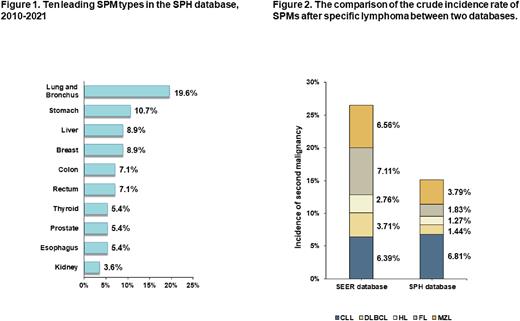Abstract
Introduction: Treatment for lymphoma has undergone significant transformation in the past decade with the introduction of novel treatment strategies. Given the long-term treatment and supportive care, patients with lymphoma are living longer under better disease control, and patients with lymphoma are at increased risk of developing second primary malignancies (SPMs). Herein, we estimated the incidence, risk factors, and outcomes in lymphoma survivors with SPMs.
Methods: Patients diagnosed with SPMs after primary lymphoma in Shandong Provincial Hospital (SPH) from 2010 to 2021 were included. Additionally, the differences in the incidence and characteristics of SPMs across ethnic groups were delineated by comparing with the Surveillance, Epidemiology, and End Results (SEER) database. We calculated the risk of SPMs using standardized incidence ratio (SIR) and absolute excess risk (AER). Overall survival (OS) analysis was reported using the Kaplan-Meier method.
Results: A total of 2,912 hospitalized lymphoma cases were included, and 63 patients (2.16%) had SPM during the follow-up. Of these patients, 44 (69.84%) were male and 19 (30.16%) were female. The median age was 61 years old (range 35-81) and the majority of patients diagnosed with SPMs were older (≥60 years old, 61.90%) and previously treated with chemotherapy (69.84%). Histopathologic subtypes of primary lymphoma were as follows: (1) Hodgkin's lymphoma (HL, 3.17%), (2) non-Hodgkin lymphoma (NHL, 80.96%), and (3) Unknown type (15.87%). Chronic lymphocytic leukemia/small lymphocytic lymphoma (CLL/SLL) and diffuse large B-cell lymphoma (DLBCL) were the most common subtypes.
The median duration between SPMs and lymphoma was 3.14 years (range 0-9). The most common types of SPMs were digestive system tumors (27, 42.86%), respiratory system tumors (13, 20.63%), and urinary system tumors (8, 12.70%). Specifically, the common types of SPMs were lung (19.6%), stomach (10.7%), and liver (8.9%) (Fig. 1). In addition, 304,696 new lymphoma cases are diagnosed, as reported to SEER 18 registries from 2010 through 2018, and 13580 survivors (4.46%) had SPMs. As described above, these patients with SPMs were also mostly male and older when diagnosed with SPMs. The commonly diagnosed SPMs are NHL (17.7%), lung and bronchus cancer (12.1%), and prostate cancer (10.0%).
Additionally, we showed that the incidence rate of SPMs after specific lymphoma in the SEER database was higher than that of the SPH database other than CLL (Fig. 2). Because the crude incidence rate of SPM was not adjusted for the expected number of lymphoma or the number of high-risk patients in a reference population, the SIR and AER of SPM were calculated in the further analysis. Among patients at lymphoma diagnosis, overall malignancy risk was significantly higher than expected in the U.S. general population after follicular lymphoma (FL, SIR=2.01; 95%CI 1.93-2.09), marginal zone lymphoma (MZL, SIR=1.78; 95%CI 1.68-1.88), HL (SIR=1.76; 95%CI 1.62-1.91), CLL/SLL (SIR=1.51; 95%CI 1.46-1.57) and DLBCL (SIR=1.45; 95%CI 1.39-1.5). Moreover, hematological malignancies (SIR=3.23; 95%CI 3-3.48) contributed more to the SPMs than solid-organ cancers (SIR=1.31; 95%CI 1.226-1.27) among these subtypes.
In a multivariate analysis, most patients with SPMs were diagnosed at younger ages (<55 years) and found to be other (Asian or Pacific Islander, American Indian/Alaska Native) races. Additionally, a higher mortality rate is associated with advanced age, no rituximab-based chemotherapy, and latency (P<0.05). We found that OS is shorter for patients with SPMs compared with those without SPMs, with increasing divergence over time (P<0.00001). In further analysis, we compared the survival of the most common SPMs in people who were diagnosed with specific lymphoma. The results showed that lymphoma patients with NHL, urinary bladder, stomach, and lung cancer experienced worse survival compared with melanoma, thyroid, kidney, and breast cancer (P<0.00001).
Conclusion: Our study illustrated the incidence, mortality, and related risk factors of SPMs in specific lymphoma survivors and showed that the incidence of SPMs after the lymphoma is higher in older men, particularly in lung cancer. We found an increased risk for lymphoma compared to the general population. More studies are needed to understand the molecular underpinning leading to increased SPM formation in lymphoma patients.
Disclosures
No relevant conflicts of interest to declare.
Author notes
Asterisk with author names denotes non-ASH members.


This feature is available to Subscribers Only
Sign In or Create an Account Close Modal